Study on farm forests
The Malaysian Timber Council, together with the
Malaysian Panel-Products Manufacturers’ Association
(MPMA), recently visited Central Java to gain a better
understanding of community farming as practised by the
smallholders in Indonesia as well as its potential to boost
wood supply for the industry and to improve the livelihood
of the local community.
4.
INDONESIA
New direction for SVLK
The Timber Legality Verification System (SVLK) has
been transformed into a Legality and Sustainability
Verification System in which Indonesia has a commitment
to produce verified legal and sustainable timber products.
The Secretary General of the National Accreditation
Committee (KAN), Donny Purnomo, said that to ensure
consistency and competence in the application of SVLK it
is necessary to coordinate with all stakeholders.
In the future, to simplify the system, the accreditation
currently carried out by multiple agencies will be
conducted by one entity, the Independent Verification
Assessment Agency (LPVI).
This merger will be very beneficial because, in addition to
saving accreditation costs, it will also allow the
implementation of assessments to be carried out
simultaneously, said Purnomo.
The chairman of the Committee for Organisational
Development, Human Resources and Regional
Strengthening of APHI, Tjipta Purwita, said that the
SVLK generates a positive image of responsible forest
management. He added that good forest management
should be supported with incentives.
See:
https://forestinsights.id/2022/10/29/akreditasi-dansertifikasi-mendukung-kelestarian-hutan-svlk-harus-diterapkankonsisten/
Overseas representatives asked to promote SVLK
Indonesia's forestry sector has great potential to support
green growth through the use of wood products and other
forest products. Support from overseas diplomats to
promote the forestry sector can expand opportunities.
During an event on capacity building for diplomats with
the theme "Indonesian Forests: Sustainability and
Competitiveness” the chairman of the Indonesian Forestry
Community Communication Forum (FKMPI), Indroyono
Soesilo, asked for the support of Indonesian
Representatives abroad to promote the country’s SVLK.
Indroyono explained that, to address the issue of illegal
logging and sustainability, Indonesia has developed a
Legality and Sustainability Verification System (SVLK).
Another issue that has been answered through the
government policies is deforestation. According to
Indroyono, various Indonesian government policies have
succeeded in keeping the rate of deforestation very low.
See:
https://forestinsights.id/2022/10/26/promosi-produk-kayubutuh-dukungan-diplomasi-diplomat-ri-data-pengelolaan-hutantepis-stigma-negatif/
Cooperation to support SFM and inclusive growth
To support the Indonesian government in achieving its
FOLU Net Sink the Tropical Forest Alliance (TFA) and
the Indonesia Business Council for Sustainable
Development (IBCSD) is encouraging a deforestation-free
supply chain through sustainable and inclusive forest
management.
Together with the Indonesian Chamber of Commerce and
Industry TFA supports a communication platform for
sharing information and supports good forest practices to
attract investment.
The TFA and the Investors Policy Dialogue on
Deforestation (IPDD) and the Indonesian Chamber of
Commerce and Industry (KADIN) signed a cooperation
agreement in which TFA was represented by the Indonesia
Business Council for Sustainable Development (IBCSD)
as an entity of the Tropical Forest Alliance (TFA) in South
East Asia. The signing of this MoU is to support the
achievement of the FOLU Net Sink 2030 climate agenda
through sustainable and inclusive forest management.
See:
https://wartaekonomi.co.id/read456640/tropical-forestalliance-dan-kadin-tandatangani-kerjasama-dukung-pengelolaanhutan-yang-berkelanjutan-dan-pertumbuhan-yang-inklusif
Boosting forest management capacity
The Ministry of Environment and Forestry is determined
to raise the institutional capacity of Forest Management
Units (KPHs) and communities to encourage communitybased
sustainable forest management.
Agus Justianto, Director General of Sustainable Forest
Management in the Ministry, said the Forest Investment
Programme 2 (FIP2) project is designed to strengthen the
institutional capacity of KPHs and local communities so
that decentralised forest management can improve forestbased
livelihoods.
See:
https://en.antaranews.com/news/256949/ministrycommitted-to-boosting-capacity-of-forest-management-units
Successful reduction of forest fires
The Minister of Environment and Forestry, Siti Nurbaya,
said Indonesia succeeded in reducing land and forest fires
over the past three years. The Minister reported this when
speaking virtually at the Indonesia Pavilion of the 27th
Conference of Parties of the UNFCCC (COP-27) in Sharm
el-Sheikh.
Data shows land and forest fires covered an area of
296,942 hectares in 2020, 358,867 hectares in 2021 and
183,743 hectares in the year ended September 30, 2022.
In related news, the Director of Forest and Land Fire
Control in the Ministry of Environment and Forestry,
Basar Manullang, said forest and land fires in Indonesia
were mainly caused by human activity. Activities that can
trigger forest and land fires include land clearing to build
settlements or create farmland.
See:
https://en.antaranews.com/news/258849/indonesiasuccessfully-curbed-land-forest-fires-during-2020-2022
and
See:
https://en.antaranews.com/news/256905/minister-attributesforest-land-fires-chiefly-to-human-activities
MoU for biomass supply
The Indonesian Embassy in Japan has facilitated the
signing of a Memorandum of Understanding between PPT
Energy Trading (PPT ET) of Japan and PT. Agro Industri
Mandiri and T Inti Persada of Indonesia for the supply of
biomass.
In addition, the Embassy facilitated the signing of an MoU
between PT Riu Mamba Karya Sentosa and PT Alam
Bumi Cemerlang in Fukuoka, Japan to conduct a study for
the construction of wood pellet plant in the country.
See:
https://www.bioenergy-news.com/news/enhancedcollaboration-for-biomass-sector-between-japan-and-indonesia/
See:
https://en.antaranews.com/news/255681/indonesia-norwayink-emission-reduction-agreement
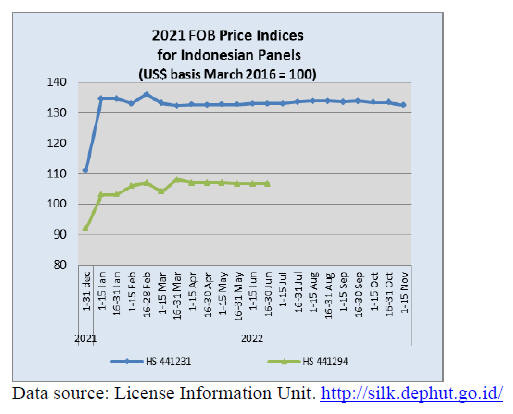
5.
MYANMAR
Pressure from UN
Chief and ASEAN leaders
Speaking at the 12th ASEAN-UN Summit, Secretary-
General, António Guterres, drew attention to the political,
security, human rights and humanitarian situation in
Myanmar saying the state is “sliding ever deeper into
catastrophe”. The UN chief continued, condemning the
escalating violence, disproportionate use of force and
“appalling human rights situation” in the country.
Recalling that under international law, indiscriminate
attacks on civilians may constitute war crimes, he repeated
his call that the Myanmar authorities “release all political
prisoners and launch an inclusive process immediately to
return to the democratic transition” as “the only route to
lasting peace and security”.
Welcoming ASEAN’s Five-Point Consensus, he urged all
countries to “seek a unified strategy” centred on the needs
and aspirations of the people of Myanmar and advocated
for open borders, protection and assistance for refugees.
See:
https://news.un.org/en/story/2022/11/1130507
More on blacklisting
Blacklisting by the Financial Action Task Force (FATF) is
very rare and places countries that show technical and
political deficiencies in anti-money laundering on the
blacklist. Myanmar is only the third member of this ‘club’
along with North Korea and Iran.
Since the military coup in Myanmar in 2021, EIA’s
Forests campaigners have been investigating and exposing
the illicit timber trade from Myanmar to international
markets.
The Financial Action Task Force (FATF) is an intergovernmental
body that sets global standards for curbing
money laundering and terrorist financing. If, during the
FATF review process, a country is found to be deficient in
tackling money laundering, it can be placed on the socalled
grey list, under which a series of measures must be
implemented to regain compliance.
The strongest measure in the FATF toolbox is formally
known as a “Call for Action”, effectively a blacklist under
which a country can be effectively cut off from the global
financial system.
See:
https://eia-international.org/blog/myanmar-blacklisted-byfinancial-watchdog-to-curb-military-juntas-exploitation-ofnatural-resources/
Border trade flourishing
It has ben reported that the Myanmar-Thailand border
trade is booming. The value of Myanmar’s bilateral trade
with Thailand through land borders registered a significant
increase of US$365.7 million between April and October
of the current financial year 2022-2023 as against a yearago
according to statistics issued by the Ministry of
Commerce.
The Ministry reported that in trade with Thailand exports
surpassed imports with exports reaching over US$1.98
billion and imports valued at over US$934.33 million.
Similarly, Myanmar’s exports have been exceeding
imports in the cross-border trade with Bangladesh. It has
been reported that the Maungtaw border post in Rakhine
State has been closed since September but exports are
flowing out of the Sittway border post to Bangladesh.
Trade via the Maungtaw border saves time and trade flow
is smooth. It takes about five hours to reach the
Bangladesh border through Sittway.
See:
https://www.gnlm.com.mm/myanmar-thailand-border-tradesurges-by-365-7-mln-as-of-21-oct/
and
https://www.gnlm.com.mm/myanmar-earns-10-733-mln-fromexports-to-bangladesh-in-7-months/
6.
INDIA
Wholesale price
indices
The Office of the Economic Adviser, Department for
Promotion of Industry and Internal Trade has published
wholesale price indices for September 2022.
The annual rate of inflation based on the Wholesale Price
Index was 10.7% in September 2022 compared to 12.4%
in September 2021.
Inflation in September 2022 was once again primarily
because of the rise in prices of mineral oils, food products,
crude petroleum & natural gas, basic metals, chemical
products and electricity.
The index for manufacturing declined in September to
142.5 from 143.2 for August 2022. Out of the 22 NIC twodigit
groups for manufactured products 12 groups
witnessed an increase in prices while 8 groups have seen a
decline.
See:
https://eaindustry.nic.in/pdf_files/cmonthly.pdf
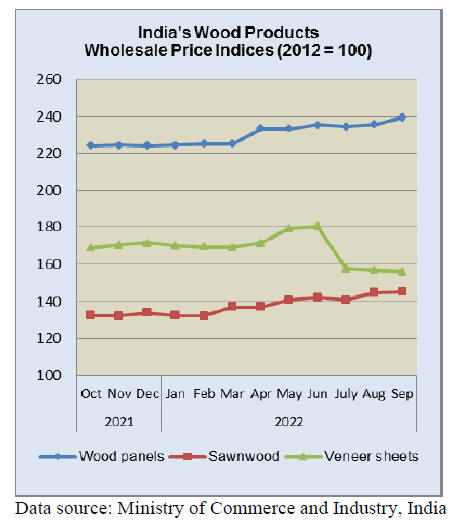
Interest rate increases not deterring home buyers
While the risk of recession looms around the world drives
down consumer sentiment and delays investment in new
homes even with rising interest rates Indian consumers are
shopping for homes. Interest rates have risen in India as
the Reserve Bank of India (RBI) moves to combat
inflation but, as yet, the rate rises have not deterred home
buyers.
According to the RBI, India’s housing price index (HPI)
recorded an annual growth of 3.5% in the first quarter of
fiscal 2022 compared to 1.8% growth in the previous
quarter.
India’s housing sector has seen a sharp revival in demand
and is now up to its pre-pandemic level. This was a
surprise as house prices and sales rose hand in hand during
this period.
It has been suggested that the pandemic changed
everything including consumer behaviour, buyer type, the
way of searching for properties and even prices and it is
now the young generation that are the main drivers of
demand.
Millennials (the so-called Ola/Uber generation) have
emerged as the key demand drivers and this is the result of
the prevailing uncertainties, stock market volatility and
financial sector incidents according to Anuj Puri, chairman
of the ANAROCK Group. Many millennials now prefer
buying over renting homes which provides a sense of
security associated with physical assets.
See:
https://capital.com/india-house-price-crash-propertysentiment-interest-rates
Wood based panel production set to rise
Wood is now becoming the key raw material driving
growth in the wood panel sector especially plywood,
MDF, and particleboard.
As wood raw materials are becoming scarce in Northern
States it is the Southern Indian States that are attracting
investment in wood based panels. The Mysore belt in
Karnataka is attracting new factories as the region is a key
supply point for eucalyptus.
In Gujarat, Surat based Krifor Industries recently started a
particleboard mill and the Gmica group is about to begin
production in January. Gandhidham based Lohit Boards
aims to begin production this year also and two more
particleboard plants are expected to begin production of
wood based particleboard in Gujarat. Ply-Reporter
estimates suggest 2023-24 will be a significant year for
new wood based particleboard and cumulative Indian
capacity would be doubling by 2024.
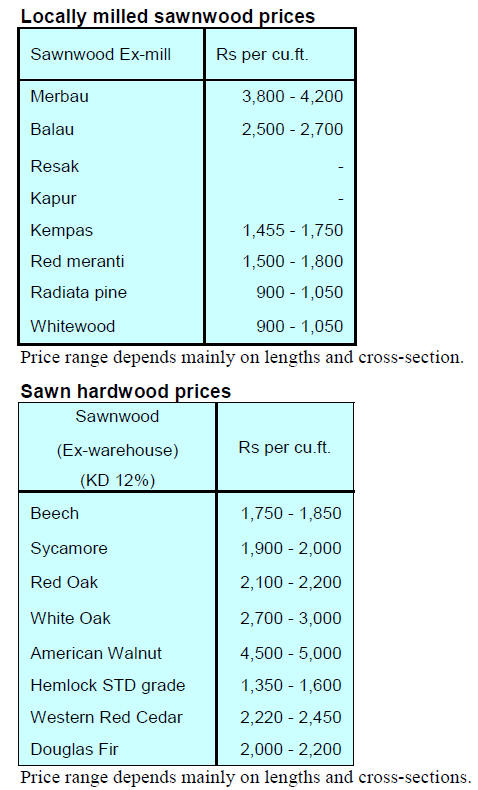
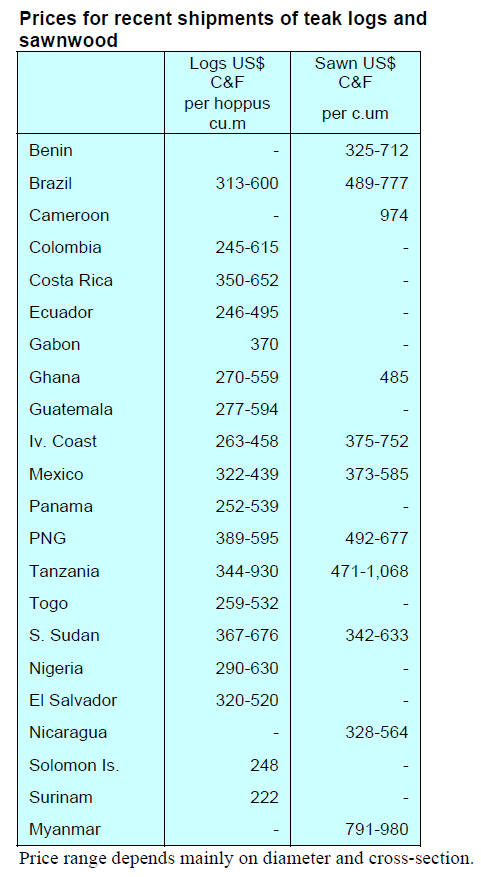
Plywood
Please note plywood prices are now shown below free of
local taxes.
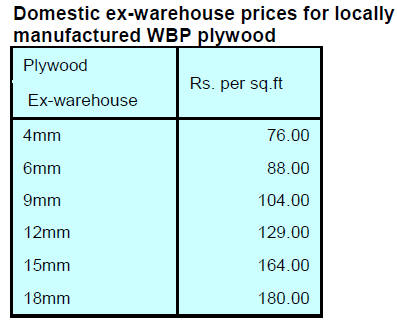

Results of sandalwood disease publishede
Researchers from National Centre for Cell Science
(NCCS) and Bengaluru’s Institute of Wood Science and
Technology have published the results of their study on
why sandalwood spike disease (SSD) has almost wiped
out sandalwood from forests of southern India.
See:
https://indianexpress.com/article/cities/pune/disease-wipingsandalwood-population-south-india-seedlings-8261225/
7.
VIETNAM
Wood and wood product
export update
Wood and wood product (W&WP) exports in October
2022 are estimated at US$1.2 billion, up 8% compared to
September 2022 and up 26% compared to October 2021.
WP exports in particular are estimated at US$747 million,
up 2% compared to September 2022 and up 19%
compared to October 2021.
Over the first 10 months of 2022 W&WP exports were
US$13.5 billion, up 11% over the same period in 2021.
WP exports accounted were US$9.3 billion, up 3% over
the same period in 2021.
Wood imports in October 2022 are estimated at 660,700
cu.m, worth US$241.1 million, up 31% in volume and
31% in value compared to September 2022. Compared to
October 2021, imports increased by 65% in volume and
55% in value.
Over the first 10 months of 2022 wood imports amounted
at 5.236 million cu.m, worth US$2.0 billion, down 5% in
volume but up 8% in value over the same period in 2021.
Exports of NTFPs, including rattan, bamboo, sedge etc. in
October 2022 reached US$60 million, up 22% compared
to September 2022 but down 13% compared to October
2021. In general, over the first 10 months of 2022 NTFP
exports contributed US$703.20 million to overall exports.
In October 2022, Vietnam's W&WP exports to EU
markets reached US$39 million, up 6% compared to
October 2021. Over the first 10 months of 2022 W&WP
exports to EU markets reached US$513.3 million, up 6%
over the same period in 2021.
Exports of living room and dining room furniture in
October 2022 contributed US$222.6 million, up 33%
compared to October 2021. Over the first 10 months of
2022 exports of living room and dining room furniture
were valued at US$2.57 billion, up 3% over the same
period in 2021.
Pine imported into Vietnam in October 2022 reached
96,200 cu.m, worth US$24.0 million, up 30% in volume
and 31% in value compared to September 2022. Compared
to October 2021, imports increased by 19% in volume and
0.3% in value.
Over the first 10 months of 2022, pine wood imports
reached 897,700 cu.m, worth US$246.7 million, down 26%
in volume and 16% in value over the same period in 2021.
W&WP exports dropping
Over the first 10 months of 2022 W&WP exports reached
US$13.5 billion, a year-on-year growth of 11.4%. Of this,
WP exports were valued at US$9.3 billion, up just 3%
over the same period in 2021. The majority of the growth
has been mostly in woodchips and wood pellets.
From May 2022 W&WP exports tended to drop and the
exports in September decreased sharply compared to that
in August 2022 as many businesses were lacking orders
and operating at modest level. Under the current business
conditions, W&WP exports for the year may not achieve
the US$16.5 billion target.
Contrary to previous years when W&WP exports often
increased in the last months of the year this year with the
economic recession and high inflation in major markets
exports are trending down since the beginning of the
second half of the year.
Woodchip exports have achieved a record growth due to
the escalating demand from China. Similarly, wood pellet
exports, mostly to South Korea and Japan for power
generation, have been experiencing high growth.
In recent months W&WP exports to the US, the top
market, have been decelerating. Over the first 9 months of
2022 exports to the US recorded at US$6.8 billion, up 2%
over the same period in 2021.
Unlike the US market, exports to Japan, China and South
Korea are increasing. In Japan and Korea, in particular,
there is high demand for wood pellets. In addition, the
potential to export wooden furniture to these markets is
also very positive because these markets are less affected
by inflation while the demand of wooden furniture is
recovering.
Wood imports from the US and EU falling
In October 2022 wood import volumes were 660,700
cu.m, equivalent to US$241.1 million up 31% in volume
and 31% in value compared to September 2022. Compared
to October 2021, the volume increased by 65% in volume
and 55% in value.
Over the first 10 months of 2022 imports of this item are
estimated at 5.24 million cu.m, worth US$2.0 billion,
down 5% in volume but up 8% in value over the same
period in 2021.
The volume of non-tropical timbers including pine, ash,
poplar, oak, eucalyptus and spruce imported for export
furniture manufacturing decreased due the scarcity of
overseas orders. On the contrary, imports of
tropical/expensive hardwoods (tali, padauk, rosewood,
walnut etc.) for the domestic market increased.
In the first 9 months of 2022 pine topped the imports
(17.5%) reaching 801,500 cu.m, worth US$222.6 million
year-on-year down by 29% in volume and 17% in value.
Ash wood imports decreased by 2.4% in volume but
increased by 10% in value, reaching 361,000 cu.m, worth
US$94.6 million accounting for 7.9% of the total imports.
Cottonwood imports decreased by 12% in volume but
increased by 8.5% in value with a volume of 291,000
cu.m, worth US$146.1 million. Imports of other major
species dropped - oak down 10%, eucalyptus down by
13%, spruce by 2.1%, and fir by 0.5%.
VAT refund delays spell trouble for wood exporters
The Association of Vietnam Timber and Forest Product
(VIFOREST) has written to the Ministries of Agriculture-
Rural Development and Finance proposing removing
obstacles in verifying replanted-forest wood for a VAT
refund. According to VIFOREST, until now the VAT
refund is stuck.
Under the prevailing regulations the time limit for VAT
refunds should not exceed 40 days upon the tax
authorities’ receipt of the valid dossiers filed by the
enterprises. The outstanding amount due to exporters has
reached VND1,000 billion.
The VAT refund delays have caused some wood exporting
enterprises to suspend exports and limit operations. If the
situation continues, many wood exporting enterprises will
be forced to close their businesses negatively affecting the
replanted-forest wood supply, including millions of forest
farmers.
There is a bottleneck in the VAT refund settlement process
because of the inconsistency of forest products-origin
tracing regulations between the General Department of
Taxation and the Ministry of Agriculture and Rural
Development.
The requirement for each locality and forest owner to
verify in detail the wood origin made by the above
authorities is not practical as there are multiple
intermediaries in the supply chain.
VIFOREST therefore proposed the ministries maintain
consistency in guiding the enterprises to verify wood
origin. It also requested the tax authorities to carry out
VAT refund settlements for the enterprises at the earliest.
See:
https://english.thesaigontimes.vn/vat-refund-delays-spelltrouble-for-wood-exporters/
Falling orders put brake on enterprises
Profits of many industrial sector companies are slowing
down, preventing a recovery of the economy and wood
and timber groups are feeling the pinch perhaps more so
than others.
A decline in export orders and reduced working hours are
widespread especially in labour-intensive industries such
as textiles, footwear and wood. The situation is expected
to last at least until the end of the year as demand in the
main export markets, the United States and Europe,
continues to fall.
For Vietnam’s wood and timber industry the sharp drop in
orders is dragging down the country’s export growth and
has been like this for three consecutive months.
In the five previous years Vietnam’s wood exports
increased by 10-20% annually and many companies said
they had expanded their investment which gave hope for
record growth in the coming years.
In May this year Truong Thanh Wood Industry Group in
the southern province of Binh Duong wanted to increase
the capacity of factories and lease an MDF board factory
to be self-sufficient in raw materials. That was at a time
when many Vietnamese wood companies heavily invested
in expansion and believed that exports of timber and forest
products would reach US$20 billion by 2025.
However, despite optimistic signs, Vietnam’s exports of
wood and forest products have now declined for three
consecutive months with exports in July only reaching
US$1.41 billion, down 5.5% compared to June and 1.6%
over the same period in 2021. Orders declined in most of
Vietnam’s main export markets such as the US and EU.
According to a survey by Forest Trends and local
associations of 52 businesses, 33 out of 45 enterprises
currently exporting to the US said their revenues had
decreased by nearly 40%. Compared to the first months of
the year only 10 enterprises reported an increase in
revenue compared to the previous months but the rise was
very low, only around 11% on average.
Firms exporting wooden furniture to the EU market were
also in a similar situation. Among the 38 enterprises
participating in this market, 24 reported that their revenue
dropped by over 40% compared to the previous months
and only four reported an increase in revenue.
The survey by Forest Trends also showed that 44.2% of
businesses said they could hold out for another 3-6
months, and 23% said they could hold out for more than
12 months. However, 19% said they could only survive for
the next three months without new orders.
As more wood manufacturers have to look for new
markets to make up for the shortage of orders, there is
another headache related to incomes and jobs for workers.
Since the end of June, Great Veca Co., Ltd. in the southern
province of Dong Nai has cut production due to a sharp
drop in orders. The company’s failure to better organise
production has dragged down the income of employees to
around US$215 per month. Under normal order conditions
the basic salary of employees would be in the range of
US$300-430 per month.
Meanwhile, the situation in Binh Duong is also grey.
Thuan An Wood JSC has gave employees a rotational
leave in August. According to the company, since July
orders from Europe, which account for over 90% of its
exports, decreased in almost all segments such as beds,
cabinets and chairs.
Nguyen Liem, chairman of the Binh Duong Wood
Processing Association, said, “The labour force at wood
enterprises in Binh Duong has now been reduced by
100,000 people compared to before the recent COVID-19
pandemic.”
Vietnam’s wood processing industry is mainly
concentrated in Dong Nai, Binh Duong, Binh Dinh and Ho
Chi Minh City.
However, Do Xuan Lap, chairman of the Vietnam Timber
and Forest Product Association, said, “Companies are
under a lot of pressure from bank loans, input materials
and other costs like labour, exports, and transport. It will
be very difficult to achieve the current export target of
US$16.5 billion in 2022.”
Although there is speculation about when the global
market demand will recover, there is much consensus that
export orders by the end of the year will not be as high as
previously.
Forest Trend’s quick survey also backed up this trend as
about 70% of businesses said that orders until the end of
the year will continue to decrease.
Truong Thanh Wood is now trying to diversify its markets
by expanding exports to the Middle East and Russia to
find a way to offset its losses.
See:
https://vir.com.vn/order-cuts-put-brakes-on-woodenterprises-96053.html.
8. BRAZIL
Promoting micro and
small furniture industries
In October Paraná State, the third largest furniture
producer in the country, along with the Brazilian Furniture
Industry Association (ABIMÓVEL) and the Brazilian
Support Service to Micro and Small Businesses
(SEBRAE) announced a ‘Furniture Industry Development,
Competitiveness and Integration Project’ (PDCIMob).
The goal is to foster the competitiveness of micro and
small businesses in the furniture sector. The PDCIMob
project aims at guiding micro and small furniture
companies on sectoral and digital intelligence,
competitiveness improvement.
Furniture production in Paraná State accounts for 14% of
the total in Brazil. There are around 2,500 companies
based in the State according to data from Brazil Móveis
2021, a report commissioned by ABIMÓVEL/Market
Intelligence Institute (IEMI). In Paraná State the furniture
sector employs around 40,300 workers or 15% of the
country's sector workforce.
See:
http://abimovel.com/projeto-de-fomento-as-micro-epequenas-industrias-moveleiras-chega-ao-parana/
CIPEM discusses sustainable timber and forest
development
The Center for Timber Producers and Exporters of Mato
Grosso State (CIPEM) will discuss the interests of forest
sector during an event "Sustainable Timber - the future of
the market" to be held in March 2023 in São Paulo.
The first meeting on "Sustainable Timber" organised by
the National Forum of Forest-Based Activities (FNBF)
with the support of CIPEM will aim to present and demystify
the process of sustainable forest management in
Brazil. To this end, the programme will approach this from
three angles - sustainability, markets and innovation. The
aim is to improve the system for the identification of
managed timber species.
Another issue that was discussed was the support to the
Federal University of Pará (UFPA) project for the
development of a web application to maximise the
accuracy of the recognition of forest species by means of
digital images of tree bark and sapwood.
According to CIPEM the technology under development
will minimise any negative financial impact caused as a
result of inconsistencies in the information in forest
inventories. The Forest Development project aims to
secure financial resources from the Forest Replacement
Fee to support afforestation, reforestation, sustainable
forest management, forest research, technical assistance
and forest extension activities.
See:
https://cipem.org.br/noticias/setima-reuniao-de-diretoria-docipem-discute-projeto-madeira-sustentavel-fundo-desenvolvefloresta-e-empossa-nova-diretoria-do-sindilam
Brazilian furniture exports
The number of destinations for Brazilian furniture jumped
from 148 in 2016 to 167 in 2021. In 2021 wooden
furniture exports earned US$772.0 million, significantly
higher than US$451.8 million obtained in 2017. The
furniture sector's export revenue in 2021 exceeded US$1
billion when including furniture parts and components, an
increase of 64% in five years. In terms of export
destination for Brazilian wooden furniture in 2021 the
main market was the United States at 36% of the total
exported. In the first half of 2022 this amount was even
higher at 44%.
Exports to countries such as Chile (11.6%), United
Kingdom (7.2%), Uruguay (6.8%) and Peru (5.7%) also
stand out. From 2017 to 2021, Brazilian furniture exports
grew by an average of 18% per year, while global exports
grew by 9.8% per year. These indicators are even more
significant when looking at the evolution of the companies
associated with the Brazilian Furniture Project, which, in
the same period, increased their exports by 25% per year.
See:
http://abimovel.com/exportacoes-de-moveis-e-colchoesbrasileiros-crescem-acima-da-media-global-nos-ultimos-cincoanos/
Wood-based panels in the 1st half of 2022
The consumption of wood-based panels in Brazil dropped
sharply in the first half of this year reaching 3.40 million
cu.m, 17% lower than in the first half of 2021 according to
IBÁ (Brazilian Tree Industry).
However, the volume exported by Brazilian manufacturers
rose 31% in the first half to 862,000 cu.m. The value of
Brazilian exports of wood-based panels also saw a
significant growth in the same period jumping 74%
compared to the first half of 2021.
Latin America was the main regional market for Brazilian
wood-based panel exports in the period, accounting for
US$126.3 million of total exports in the first half of the
year. While the North American market remained among
the main export destinations at US$107.1 million.
See:
http://abimovel.com/consumo-e-exportacoes-de-paineis-demadeira-no-1o-semestre-de-2022/
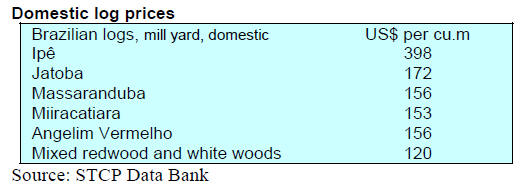
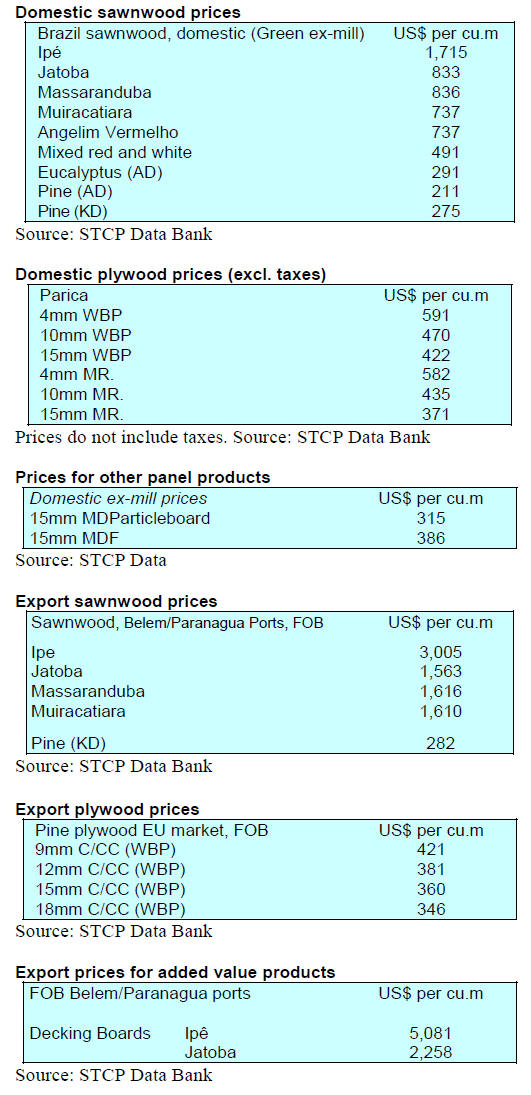
9. PERU
Exports of
semi-manufactured decline
Peru’s exports of semi-manufactured wood products
between January and August were valued at US$46.1
million, a contraction of 2.7% compared to the same
period in 2021 according to the management of the
Services and Extractive Industries Division of the
Association of Exporters (ADEX). Last year (January-
August) a growth of 45% was achieved compared to 2020
(US$32.6 million) and there was optimism that shipments
were recovering.
2022 shipments left from Lima; US$25.2 million followed
by Ucayali; US$13.6 million and Madre de Dios; US$6.9
million. Smaller amounts were shipped from the cities of
Callao, Pasco and Tacna.
The most important destination for semi-manufactured
wood products in the first 8 months of this year was
France (US$14.9 million) an increase of 10.5% and
displacing China (US$9.8 million) as the main market.
Exports to China dropped 43%. Other markets were
Belgium (US$6.3 million), Denmark (US$4.7 million),
USA (US$2.6 million), Germany (US$1.8 million) and
New Zealand (US$1.3 million).
Companies advised on State purchases
In early November an Accreditation Day was held for
companies in the wood sector to be part of the (electronic)
Perú Compras which allows speeding up contracts with
the public sector. Also, as part of the day, a workshop
"Opportunities to sell to the State" was held.
The goal is for timber companies to be advised on the
requirements they must meet to make their sales to the
State. In this way wood suppliers will have greater
opportunities to carry out commercial agreements with the
different public institutions.
The workshop was led by Peru Compras and had the
support of CITEforestal Pucallpa and the National
Forestry and Wildlife Service (SERFOR).
Forest technology workshop
In order to promote sustainable forest development and
management a workshop 'APP MIBOSQUE - Technology
to connect the State with forest users' was held. It was
attended by the past president of ADEX, Erik Fischer
Llanos and the head of Osinfor, Lucetty Ullilen Vega.
“The APP facilitates the fulfillment of obligations in a
timely, agile and secure manner. Having reliable, fast tools
available to everyone is important in this changing
national and international context”, said Fischer Llanos.
Peruvian businessmen at IWF Atlanta 2022
A group of Peruvian businessmen participated in an
important fair in North America, the IWF Atlanta 2022,
where they could experience new technologies for the
wood and furniture industry.
Paricipants stated that the IWF 2022 offered them the
opportunity to meet more than 900 exhibitors who
presented machinery, services and supplies in more than
540 product categories. More than 25,000 attendees from
all over the world (92 countries, including Peru) attended.
The Peruvian businessmen said they were satisfied to see
the technological dynamism in which the manufacture of
machinery for wood advances.



